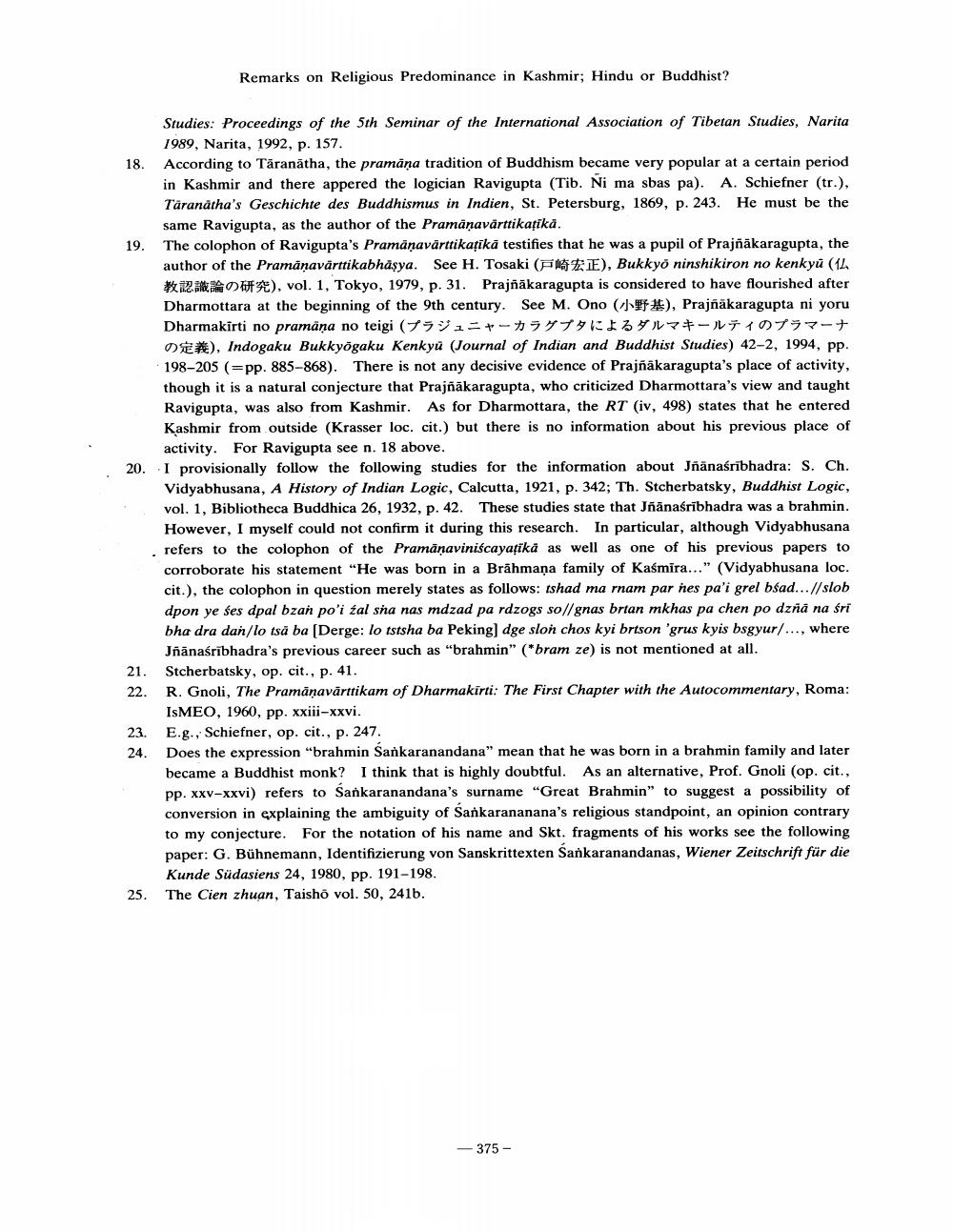Book Title: Remarks On Religious Predominance In Kashmir Hindu Or Buddhist Author(s): Toru Funayama Publisher: Toru Funayama View full book textPage 9
________________ Remarks on Religious Predominance in Kashmir; Hindu or Buddhist? Studies: Proceedings of the 5th Seminar of the International Association of Tibetan Studies, Narita 1989, Narita, 1992, p. 157. 18. According to Taranatha, the pramana tradition of Buddhism became very popular at a certain period in Kashmir and there appered the logician Ravigupta (Tib. Ni ma sbas pa). A. Schiefner (tr.), Taranatha's Geschichte des Buddhismus in Indien, St. Petersburg, 1869, p. 243. He must be the same Ravigupta, as the author of the Pramanavarttikatika. 19. The colophon of Ravigupta's Pramanavarttikatika testifies that he was a pupil of Prajnakaragupta, the author of the Pramanavarttikabhasya. See H. Tosaki ( EE), Bukkyo ninshikiron no kenkyu (14 W W F), vol. 1, Tokyo, 1979, p. 31. Prajnakaragupta is considered to have flourished after Dharmottara at the beginning of the 9th century. See M. Ono (NF#), Prajnakaragupta ni yoru Dharmakirti no pramana no teigi (プラジュニャーカラグプタによるダルマキールティのプラマーナ DEX), Indogaku Bukkyogaku Kenkyu (Journal of Indian and Buddhist Studies) 42-2, 1994, pp. 198-205 (=pp. 885-868). There is not any decisive evidence of Prajnakaragupta's place of activity, though it is a natural conjecture that Prajnakaragupta, who criticized Dharmottara's view and taught Ravigupta, was also from Kashmir. As for Dharmottara, the RT (iv, 498) states that he entered Kashmir from outside (Krasser loc. cit.) but there is no information about his previous place of activity. For Ravigupta see n. 18 above. 20. I provisionally follow the following studies for the information about Jnanasribhadra: S. Ch. Vidyabhusana, A History of Indian Logic, Calcutta, 1921, p. 342; Th. Stcherbatsky, Buddhist Logic, vol. 1, Bibliotheca Buddhica 26, 1932, p. 42. These studies state that Jnanasribhadra was a brahmin. However, I myself could not confirm it during this research. In particular, although Vidyabhusana , refers to the colophon of the Pramanaviniscayatika as well as one of his previous papers to corroborate his statement "He was born in a Brahmana family of Kasmira..." (Vidyabhusana loc. cit.), the colophon in question merely states as follows: tshad ma rnam par nes pa'i grel bsad... //slob dpon ye ses dpal bzan po'i zal sna nas mdzad pa rdzogs sol/gnas brtan mkhas pa chen po dzna na sri bha dra dan/lo tsa ba (Derge: lo tstsha ba Peking) dge slon chos kyi brtson 'grus kyis bsgyur/ ..., where Jnanasribhadra's previous career such as "brahmin" (* bram ze) is not mentioned at all. Stcherbatsky, op. cit., p. 41. R. Gnoli, The Pramanavarttikam of Dharmakirti: The First Chapter with the Autocommentary, Roma: IsMEO, 1960, pp. xxiii-xxvi. 23. E.g., Schiefner, op. cit., p. 247. 24. Does the expression "brahmin Sankaranandana" mean that he was born in a brahmin family and later became a Buddhist monk? I think that is highly doubtful. As an alternative, Prof. Gnoli (op. cit., pp. xxv-xxvi) refers to Sankaranandana's surname "Great Brahmin" to suggest a possibility of conversion in explaining the ambiguity of Sankarananana's religious standpoint, an opinion contrary to my conjecture. For the notation of his name and Skt. fragments of his works see the following paper: G. Buhnemann, Identifizierung von Sanskrittexten Sankaranandanas, Wiener Zeitschrift fur die Kunde Sudasiens 24, 1980, pp. 191-198. 25. The Cien zhuan, Taisho vol. 50, 241b. 21. 375 -Page Navigation
1 ... 7 8 9
